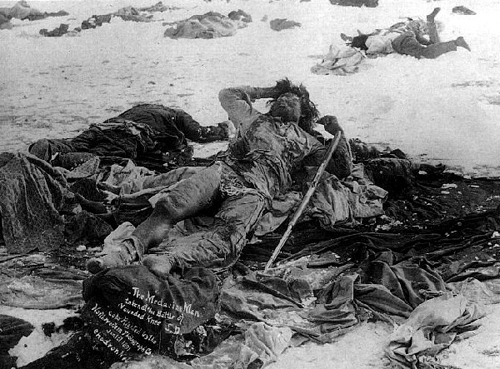
Chief Big Foot lies frozen where he and more than 150 women, children, were massacred by 7th Cavalry at Wounded Knee.
Word spread quickly through
Indian Country that Sitting Bull had been killed at Standing Rock
by members of his own tribe. Hearing this news prompted
another Sioux chief, Big Foot, to move his small band to a more
protected and remote area on the Pine Ridge reservation in South
Dakota. Army troops that had been given orders to put an end
to the Ghost Dance among the plains tribes, were on patrol in the
area when Big Foot's band began its march.

The frozen corpse of a Sioux Indian following the 7th
Cavalry's unprovoked massacre of Big Foot's band of Indians at
Wounded Knee in December, 1890. Many said this attack was
retribution for Sitting Bull anihilating George Custer's command at
the Little Big Horn in 1776.
Big Foot, who was
sick with pneumonia, flew a white flag of peace from his wagon and
readily surrendered when his band encountered the mounted
troops. The weather was clear and bitterly cold.
He agreed to have his warrior surrender as well, before traveling
on, and when the troops arrived in the morning to collect weapons
from the warriors, a gun discharged during an altercation and 500
troops opened indiscriminate fire with four howitzers and rifles
into the center of the encampment (which was mostly women,
children, and old people). One hundred and forty-six
defenseless Indians were killed, and another fifty-one were
seriously wounded. Among the survivors was a young boy
who would become famous as the spiritual leader named Black
Elk.
This was the
last battle of the Indian Wars on the
Plains.
Related People
Related Events
Related Flashpoints